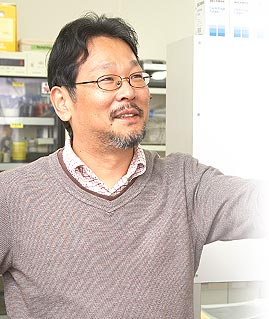
|
Program Overview > Program Members > Shinya, Suzu
|

Center for AIDS Research, Associate Professor
Hematology Ph.D. Member of Committee for Education of Young Scientists, Research on HIV-1 Nef

 |
 I have been studying for more than two decades how the proliferation and differentiation of hematopoietic cells, in particular the cells of monocyte lineage, are tightly regulated by extrinsic and intrinsic signals (Suzu et al., EMBO J 2000). More specifically, I have focused on regulatory mechanisms by signaling cascades from receptor tyrosine kinases (e.g. Fms) and non-receptor tyrosine kinases (e.g. Hck). Based on and by expanding this background, I have worked on molecular mechanisms by which HIV-1 protein Nef functions as an important pathogenetic factor of the virus in the past half decade with my colleagues, because a Src family tyrosine kinase Hck is a well-characterized binding partner of Nef. Hck is expressed in monocyte/macrophages but not in CD4+ T cells, and it is still unclear how the molecular binding accounts for Nef pathogenesis. |
|
Our main research interests are therefore to clarify functional consequences of the Nef-Hck binding that account for the pathogenetic role of Nef and to identify small-molecule compound that target the molecular binding. We initially tested how Nef affected receptor-signaling pathways arisen from macrophage-acting cytokines. As a result, we showed for the first time that Nef interfered with the signaling of Fms, the receptor for macrophage colony-stimulating factor (M-CSF), a macrophage-specific cytokine, through the activation of Hck and thereby inhibited the bioactivities of M-CSF (Suzu et al., Blood 2005). The inhibitory effect of Nef was specific to the M-CSF/Fms axis, because other cytokine receptor systems including granulocyte/macrophage-CSF (GM-CSF), interleukin-1 (IL-1) and IL-6 were unaffected by Nef. Accordingly, Nef selectively inhibited both M-CSF-dependent cell proliferation and differentiation into mature macrophages (Suzu et al., J Cell Physiol 2007). Interestingly, the inhibition was not due to overall inhibition of signaling cascades, as Nef rather enhanced the activation of extracellular signal-regulated kinase (ERK), one of MAP kinase (MAPK). The importance is that the selective inhibition of M-CSF/Fms axis is a possible trigger of the uncontrolled immune system, because M-CSF but not other cytokines including GM-CSF is essential to maintain steady-state M2-polarilized anti-inflammatory macrophages. We then revealed how the Nef-Hck binding interfered with Fms signaling (Hiyoshi et al., Blood 2008). Unexpectedly, the inhibitory effect of Nef is due to the Hck-dependent down-regulation of the cell surface expression of M-CSF receptor Fms. In the presence of Hck, Nef induced the accumulation of an immature under-N-glycosylated Fms at the Golgi, thereby down-regulating Fms. Consistent with the result mentioned above (no inhibitory effect of Nef on GM-CSF signaling), Nef did not induce the down-regulation of GM-CSF receptors. The activation of Hck by the direct interaction with Nef was indispensable for the Fms down-regulation. The accumulation of the active Hck at the Golgi where Nef pre-localized was likely to be another critical determinant of the function of Nef, because the expression of the constitutive-active forms of Hck alone did not fully down-regulate Fms. These results suggest that Nef perturbs the intracellular maturation and the trafficking of nascent Fms, through a unique mechanism that required both the activation of Hck and the aberrant spatial regulation of the active Hck. Our findings have two important implications. Nef has been shown to affect trafficking process of proteins, as exemplified by MHC I (one of the hallmark functions of Nef, which diminishes the recognition of infected cells by cytotoxic T cells). In that respect, Fms is not the direct target. However, Nef down-regulates Fms by impairing its glycosylation, which is triggered by activation/skewed Golgi-localization of Hck. It therefore appears that Nef acquires additional machinery to manipulate protein trafficking processes in macrophages by exploiting Hck. From a different standpoint, our findings imply the importance of regulated activation of Hck at the Golgi for the maintenance of the Golgi function and should help to answer a long-standing question, why a fraction of Src kinases including Hck is physiologically present at the Golgi. In addition to basic research works on Nef functions described above, we have made effort to identify small-molecule compound that target the Nef-Hck binding. We recently found that a small-molecule compound UCS15A-2c (C13H16O5, M.W. 252.26) was an effective blocker of the Nef-Hck binding (Hassan et al., submitted). UCS15A and its synthetic analogs 2b and 2c are unique in that they blocked the binding between proline-rich motifs of Nef and SH3 domain of Hck, by directly binding to Nef. 2c is the simple and more effective analog of UCS15A, the first and only non-peptide lead chemical that blocks the binding between the proline-rich motifs and SH3 domain. Accordingly, UCS15A-2c was quite effective in the blocking of the Nef/Hck-induced Fms N-glycosylation impairment, and Nef-induced MHC I down-regulation. UCA15A-2c is therefore quite useful to elucidate essential significance of Nef itself and/or the Nef-Hck binding, and may provide a new approach for anti-HIV-1 therapy. |
|

|
♦Related papers |
|
| 1. | Hiyoshi M, Suzu S, Yoshidomi Y, Hasaan R, Harada H, Sakashita N, Akari H, Motoyoshi K, Okada S. Interaction between Hck and HIV-1 Nef negatively regulates cell surface expression of M-CSF receptor. Blood 111, 243-250, 2008 |
| 2. | Suzu S, Hiyoshi M, Yoshidomi Y, Harada H, Takeya M, Kimura F, Motoyoshi K, Okada S. M-CSF-mediated macrophage differentiation but not proliferation is correlated with increased and prolonged ERK activation. Journal of Cellular Physiology 212, 519-525, 2007 |
| 3. | Suzu S, Harada H, Matsumoto T, Okada S. HIV-1 Nef interferes with M-CSF receptor signaling through Hck activation and inhibits M-CSF bioactivities. Blood 205, 3230-3237, 2005 |
 |
 |